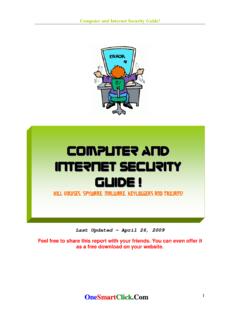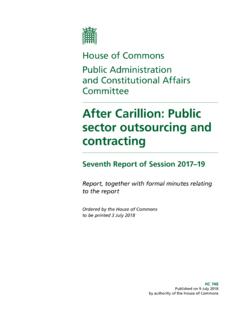Transcription of Code of Federal Regulations (CFR): Main Page
1 code of Federal Regulations , Council on Foreign Relations, Codex Alimentarius, Bilderbergs, Trilaterial Commission, Illuminati, Freemasons, United Nations Information 1 | P a g e code of Federal Regulations (CFR): Main Page The code of Federal Regulations (CFR) is the codification of the general and permanent rules published in the Federal Register by the executive departments and agencies of the Federal Government. It is divided into 50 titles that represent broad areas subject to Federal regulation.
2 Each volume of the CFR is updated once each calendar year and is issued on a quarterly basis. More. Most Current 50 Titles (2009-2010) 1996 through current year Based on CFR update schedule Browse and/or search the CFR Retrieve by CFR Citation Search tips Other Services Purchase individual CFR titles through the Government Online Bookstore. Find issues of the CFR (including issues prior to 1996) at a local Federal depository library. A service of the Government Printing Office. Last updated: April 1, 2010 Page Name: code of Federal Regulations From Wikipedia, the free encyclopedia This article needs additional citations for verification.
3 Please help improve this article by adding citations to reliable sources. Unsourced material may be challenged and removed. (January 2009) code of Federal Regulations , Council on Foreign Relations, Codex Alimentarius, Bilderbergs, Trilaterial Commission, Illuminati, Freemasons, United Nations Information 2 | P a g e Administrative law General principles Administrative court Certiorari Delegated legislation Exhaustion of remedies Habeas corpus Justiciability Legitimate expectation Mandamus Natural justice Nondelegation doctrine Patently unreasonable Polycentricity Prerogative writ Privative clause (ouster clause)
4 Quo warranto Rulemaking Ultra vires Writ of prohibition Administrative law in common law jurisdictions Australia Canada England Scotland Singapore United States Administrative law in civil law jurisdictions China Mongolia Ukraine Related topics Constitutional law Judicial review code of Federal Regulations , Council on Foreign Relations, Codex Alimentarius, Bilderbergs, Trilaterial Commission, Illuminati, Freemasons, United Nations Information 3 | P a g e v d e A few volumes of the CFR at a law library (titles 12-26).
5 The code of Federal Regulations (CFR) is the codification of the general and permanent rules and Regulations (sometimes called administrative law) published in the Federal Register by the executive departments and agencies of the Federal Government of the United States. The CFR is published by the Office of the Federal Register, an agency of the National Archives and Records Administration (NARA). The CFR is divided into 50 titles that represent broad areas subject to Federal regulation. Contents [show] [edit] Background Every regulation in the CFR must have an "enabling statute," or statutory authority.
6 The United States code ( code ) precedes the CFR and contains statutes enacted by Congress. The CFR contains Regulations , which spell out in further detail how the executive branch will interpret the law.[1] The two documents represent different stages in the legislative process. The code is a codification of legislation, while the CFR serves as administrative law. Administrative law exists because the Congress often grants broad authority to executive branch agencies to interpret the statutes in the (and in uncodified statutes) which the agencies are entrusted with enforcing.
7 Congress may be too busy, congested, or gridlocked to micromanage the jurisdiction of those agencies by writing statutes that cover every possible detail, or Congress may determine that the technical specialists at the agency are best equipped to develop detailed applications of statutes to particular fact patterns as they arise. code of Federal Regulations , Council on Foreign Relations, Codex Alimentarius, Bilderbergs, Trilaterial Commission, Illuminati, Freemasons, United Nations Information 4 | P a g e Under the Administrative Procedure Act, the agencies are permitted to promulgate detailed rules and Regulations through a public "rulemaking" process where the public is allowed to comment, known as public information.
8 After a period of time, the rules and Regulations are usually published in the Federal Register. The Parallel Table of Authorities and Rules in the index to the CFR correlates laws with their Regulations using code citations, Statutes at Large citations and Public Law numbers.[2] [edit] Effect of administrative law The rules are treated by the courts as being as legally binding as statutory law, provided the Regulations are a reasonable interpretation of the underlying statutes. This "reasonable interpretation" test or Chevron doctrine was articulated by the Supreme Court in a unanimous decision (6 voting, 3 recused) involving a challenge to new Clean Air Act Regulations promulgated by the Reagan administration in 1981.
9 See Chevron , Inc. v. Natural Resources Defense Council, Inc.[3] For example, if Congress enacted a law that simply stated that there are not to be "excessive" levels of mercury in any significant body of water in the United States (but defined things no further), an entity designated, as part of the law, to enforce it (probably the United States Environmental Protection Agency (EPA)) could define in a scientific way what an excessive level of mercury is, as well as what constitutes a significant body of water.
10 The Agency's definitions and its plan of enforcement for what Congress intended (along with listed penalties for violation coming from Congress unless Congress specified otherwise) will all go into the CFR. Also, enabling legislation can be passed by Congress which gives a Federal non-Congressional entity wide latitude in creating rules (law of bases). For example, the EPA could be designated by Congress to promulgate rules "that control harmful pollutants"; the Agency could then promulgate broad rules (including definitions and enforcement provisions), in the absence of existing specific laws, to control lead emissions, radon emissions, pesticide emissions, and so forth.





